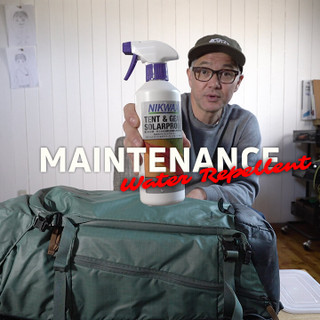GEAR MAINTENANCE: WATER REPELLENCY
Apr 20th 2020
Water Repellency Maintenance
There comes a time in an outdoor backpacks life when it needs a Water Repellency ‘re-fresh’. Most outdoor backpacks are treated with coatings commonly referred to as DWR or ‘Waterproofing’. Over-time, those coatings lose their effectiveness.
DWR means Durable Water Repellent – which is applied to the exterior of the packs shell material. It’s designed to encourage water to roll off the packs exterior and prevent it from being absorbed into the packs shell and eventually make its way inside the bag.
Waterproofing is a frequently misused term - the fact is very few backpacks are actually waterproof and the term is very misleading. Waterproof packs require materials that limit a backpacks design potential. As a result most (actual) waterproof packs are very simple and from a photographer’s perspective - not functional.
Manufacturing a waterproof pack that is useful for photographers would require a significant increase in weight, be expensive and also would be difficult to use in an efficient manner (slow access). Be cautious when you hear the word ‘waterproof’ (for both textiles and zippers). It’s often mis-spoken.
The Effects of Abrasion
Since water repellent coatings are exterior facing, they see abrasion and wear from ‘normal’ use. Anything making contact with your pack, including the ground, bushes, rocks and even your car’s trunk, gradually wear away the coating.
We use a formula called Form Carbonate on the face of our packs – it’s a resin made up of various types of polyurethanes and when it’s all mixed together, it makes a ‘super’ version of a Polyurethane protective coating. It is notable for its abrasion resistance and durability. This helps keep the coatings effectiveness working for a longer period of time.
With that said, frequent use will still wear down your backpack and just like anything that you want to use for a long time– you need to maintain it.
There are a few different options to help your packs water resistance. Below (and in the attached video) I will explain applying Instant Water Repellent by Gear Aid and Nikwax DWR spray.

Applying Gear Aid Instant Water Repellant
- You will need a can of Instant Water Repellent by Gear Aid (or similar product) and a damp cloth.
- First clean your bag by taking a damp towel and wipe down the outer surface of your bag. Don’t be to aggressive unless you have particularly dirty spots you need to clean. You can also use a mild detergent but consider anything to powerful may also wear away the coating you’re trying to maintain.
- Once your shell is clean and dry, you will need to spray on your water repellency. This should be applied outside, or a well-ventilated area, but also consider your immediate surroundings and try to control the sprays overflow.
- Keep the spray away from the zipper track. If you wanted to be extra cautious you can tape the zipper to protect them or use a piece of cardboard or plastic to block the zipper areas.
- Apply a thorough 1st coat. Gear Aid spray is an Aerosol, so it sprays relatively evenly. Once it is dry, spray another layer (still being mindful of the zippers). The reason we want to do 2 coats, is because when you apply a coating, you might miss a spot - or with the way liquid dries – it can leave little gaps in the coat. Multiple layers ensures that everywhere is covered. Also if a layer peels or is met with abrasion, it wears away at multiple layers versus just one. It ends up being a more durable product. You could compare the application to a car’s undercoating or even just painting a wall.
If you are using Nikwax, the process is the same except you will need a dry cloth to help spread the water repellency once it is applied. The Nikwax formula is more of a liquid and has greater potential to run or drip due to its fluid-like form. See video for more info.
Again, once the Nikwax is dry, apply another layer, let it dry and clean any leftover residue off.

Factory Coatings
While the core principle is the same, applying the stock factory coating is a much more intensive process. The shell is actually coated 3 times with the Form Carbonate resin. Which itself, is a much more robust coating than what you can purchase at a consumer level.
There is an assembly-line style oven that’s about 70 feet long. At one end, Nylon is mounted to rollers where it begins the coating process. The nylon is exposed approximately 1 meter while the thick resin is poured onto it. The resin is lathered evenly across the face of the material by a worker. On its way into the oven, the resin is pressed flat on the textile via tightly spaced rollers.
It travels through the oven at a temperature that won’t damage the textile but still hot enough to cure and adhere the resin. When it comes out (only a third of the way through the line), it is still on rollers where another person applies the second coat of resin and then again cured… the process is repeated one more time (3 total).
Responsibility
By maintaining your pack and re-applying Water Repellency, to a lesser extent you are mimicking what goes on it the factory when apply water protection. If you are out in the elements, you really should consider maintaining your backpack – reapplying water repellent will help protect your investment but also your camera gear. With the cost in mind and the importance a bag has on your safety and ability to live out your adventures – it should be treated like any tool – and maintained for maximum performance.
Ian Millar
Founder
Shimoda Designs
ian@shimodadesigns.com

